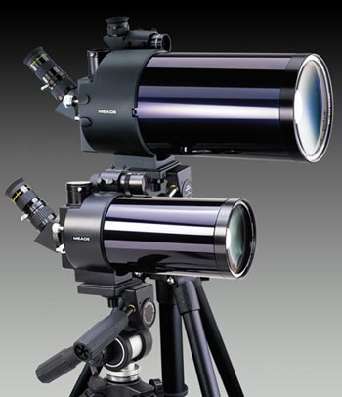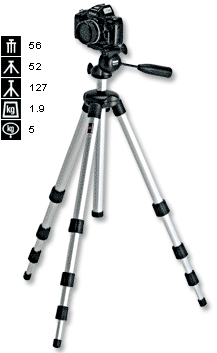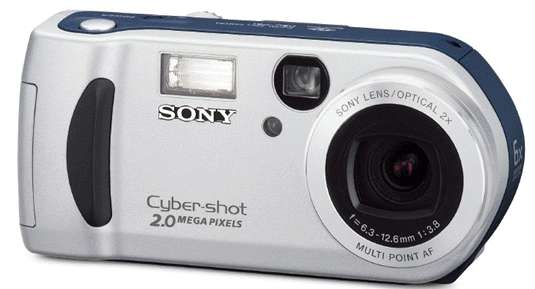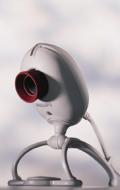Strumenti
Telescopi ed Accessori

Meade LXD 300 S.C. 203mm EMC
Specifications and Features: LXD 300-Series TELESCOPES MODEL: 8" Model 203SC/300 Optional design Schmidt-Cassegrain Diameter 203mm (8") Focal Length 2000mm f/10 Resolving power 0.56 arcsecs Coatings EMC super multi-coated Limiting Visual Magnitude (approx.) 14.0 Maximum Practical Visual Power 500X.
Optical Tube Dimensions (dia. x length) 9.1" x 16" Mounting Type LXD 300; equatorial Setting Circle Dias. R.A.: 2.5"; Dec.: 2.2" Slow-Motion Controls R.A. and Dec. Viewfinder 6 x 30mm Tripod Aluminum, adjustable Materials Tube body Mount castings Aluminum Total Net Telescope Weight 45 lbs. (20 kg.) Shipping Weight 70 lbs. (32 kg.)
LXD 300 Equatorial Mounting: Incorporating aluminum worm-gears, micrometric manual slow-motion controls, and setting circles on both telescope axes, the LXD 300 mounting permits the accurate location and centering of objects in the telescopic field and the precise tracking of these objects at any observing magnification. Fine-adjust azimuth and elevation controls allow for quick, accurate polar alignment of the telescope.
The #535 R.A. Motor Drive System provides an economical means for fully automatic tracking in Right Ascension and also includes a 2-speed (8x and 32x sidereal-rate) hand controller for image centering in R.A. The #535 R.A. Motor Drive is powered by a battery pack, included, which accepts 10 (user-supplied) AA-size batteries.
EMC treatment: The optical surfaces of all Meade telescopes include high-grade optical coatings fully consistent in quality with the precision of the optical surfaces themselves. These EMC coatings include mirror surfaces of highly purified aluminum, vacuum-deposited at high temperature and overcoated with silicon monoxide (SiO), and correcting lenses coated on both sides for high light transmission with magnesium fluoride (MgF2). Meade mirror and lens coatings equal or exceed the reflectivity and transmission, respectively, of virtually any optical coatings currently offered in the commercial telescope industry.
The optical tube assemblies entirely at the Meade Irvine, California.Meade LXD 300-Series telescopes are identical to those supplied with more advanced Meade models. Every optical system supplied with an LXD 300 telescope goes through, and must pass, precisely the same optical tests and inspections as its more advanced counterparts.
![]()
Meade ETX 90mm Maksutov EMC
Specifications and Features: ETX-90 Optical Design Maksutov-Cassegrain; Primary Mirror Diameter 96mm (3.78") Clear Aperture 90mm (3.5") ;Focal Length, Focal Ratio 1250mm f/13.8;Near Focus (approx.) 11.5 ft. (3.5m) Resolving Power (arc secs.) 1.3; Optical Coatings MgF2; standard aluminum/SiO Emc Limiting Visual Stellar Magnitude 11.7; Maximum Practical Visual Power 325X.
Optical Tube Dimensions (dia. x length) 4.1" x 11" (10.4cm x 27.9cm).8 x 21mm erect-image viewfinder;#932 45° Erecting Prism . Secondary Mirror Obstruction (dia.; %) 9.6% ,1.1" (27.9mm);
Materials: Tube body Aluminum Primary Mirror Pyrex ®; glass Correcting Lens BK7 optical glass, Grade-A Telescope; Net Weight 1.5 kg.
Optical Systems: Manufactured entirely at the Meade Irvine, California, facility ETX, Maksutov-Cassegrain optics produce stellar diffraction images virtually identical to those of the finest apochromatic refractor. Optical performance and resolution warranted to equal or exceed any Maksutov optics of similar aperture ever manufactured at any price, past or present. Optics so high in contrast, image brightness, and resolution that the ETX consistently outperforms many telescopes of larger apertures.
![]()
Super Plössls: Designed to utilize the very latest in optical glass types, Meade 4-element Super Plössls are excellent general-purpose eyepieces. For observing hairline lunar and planetary detail, splitting close double stars, or for resolving faint nebulosity in deep-space, Meade Super Plössls optimize the performance of any telescope type, whether f/10 Schmidt-Cassegrain, f/16 refractor, or f/4 reflector. All focal lengths through 32mm are parfocal. The Super Plössl 56mm eyepiece with 2" O.D. barrel yields 36X and an actual field of view of 1.4° on an 8" f/10 Schmidt-Cassegrain telescope.

Meade Series 4000 Eyepieces Super Plössl (4-elements)
Eyepieces
SP 9.7mm 52º 1.25" 206x Field 0.25' (LXD 203) 129x Field 0.40' (ETX 90)
SP 15mm 52º 1.25" 133x Field 0.39' (LXD 203) 83x Field 0.62' (ETX 90)
SP 26mm 52º 1.25" 76x Field 0.68' (LXD 203) 48x Field 1.08' (ETX 90)
SP 40mm 44º 1.25" 50x Field 0.88' (LXD 203) 31x Field 1.41' (ETX 90)

![]()
Color filters are an essential tool of the lunar and planetary observer, for filters permit the observation and photography of surface detail that is often virtually invisible without filtration. Filters solve, or greatly reduce the effects of, two basic observing problems: (a) Irradiation is the fuzzying of a boundary between lighter and darker areas of the Moon or a planetary surface and can be caused either by the effects of highly contrasting light impacting the human eye or by the motion of the Earth’s atmosphere, through which the observation is being made. (b) Contrast is the separation of adjacent surface regions according to their color; for example, a light green area on Mars can become mixed in the eye with an adjacent light yellow area, to the effect that the combined area appears yellow-green, unseparated into its component regions.

Yellow Filter (#12)
#12 Yellow (74% transmission): Contrasts strongly with blue-colored features on Jupiter and Saturn, while enhancing red and orange features. Lightens red-orange features on Mars, while reducing or blocking the transmission, and thereby increasing the contrast, of blue-green areas. Useful in increasing the contrast of lunar features in telescopes 6" aperture and larger.
- excellent for haze penetration and increased lunar contrast
- enhances the orangish desert regions of Mars by reducing the light from the blue and green areas darkening the maria, oases and canal markings
- sharpens the boundaries of Mars' yellow dust clouds
- penetrates and darkens the the low-hue blue tones of Saturn's atmosphere while enhancing the orange and red features of bands and zones
- improves the detail of Uranus and Neptune in larger telescopes (10" aperture and above) good for observating Mercury and Venus during daylight
- heightens the definition of comet tails
![]()
Light Red Filter (#23A)
#23A Light Red (25% transmission): On telescopes of 6" aperture and larger the #23A does approximately the same functions as the #21 filter, but with stronger contrast and enhancement of marginally defined blue-green surface detail. Useful primarily on Jupiter, Saturn, and Mars. Increases contrast between Mercury and bright blue sky during daylight observations or during twilight.
- increases tonal contrast in Martian maria
- reveals details in the zones and belts of Jupiter
- improves observation of Mercury when the planet is low and near the horizon
- enhances surface features of Mercury during daylight observation by reducing the brightness of the blue sky
- useful to study the bluer clouds and polar regions of Saturn
- reduces the brightness of the sky during daylight and enhance the observation of Venus, occasionally revealing deformations of the terminator
- increased lunar contrast
![]()
Green Filter (#56)
#56 Light Green (53% transmission): Excellent for the observation of Martian polar ice caps as well as yellow-tinted dust storms on the Martian surface. Increases contrast of the red and blue regions in Jupiter’s atmosphere as well as in the cloud belts. Also useful for enhancing lunar detail.
- helpful in observing yellow dust storms on Mars
- affords greater lunar contrast
- filter detail on Saturn
- improves low contrast hues of blue and red in the Jovian atmosphere
- good for observing Venus during the day and for the study of Venusian cloud patterns
![]()
Blue Filter (#80A)
#80A Blue (30% transmission): A popular filter for the study of Jupiter and Saturn. Enhances contrast of rilles and festoons in Jupiter’s cloud belts, as well as details of the Red Spot. Brings out detail in Saturn’s belts and polar phenomena. Very useful as a contrast-enhancing lunar filter.
- greater detectability of higher Martian cloud formations
- revelation of subtle details on Jupiter and Saturn, especially white spots and light zones
- increased lunar contrast under dark sky conditions
- good Jovian photography
- improved observation of Mercury at twighlight when the planet is low and near the horizon
![]()
Nd 96 Moon Filter (0.9 density; 13% transmission)
The neutral density filter transmits light uniformly across the entire visual spectrum. It serves as an excellent filter to reduce glare and irradiation when observing the Moon with any telescope 4" and larger. The ND96 filter may also be employed in the splitting of close double stars where one of the binary pair significantly exceeds the other in brightness.
- On the moon excellent for reducing irradiation , glare and subject brightness. Colors are unaltered, as light is transmitted uniformly over the entire spectrum. Each model performs somewhat differently, depending on the brightness of the moon.
- Planets stacking in combination with color filters lowers transmission, but retains true color balance for specific applications. Reduces glare on brighter planets and minimizes irradiation.
- Binary Stars helpful in splitting binary stars, because it reduces glare and diffraction effects around the brighter star of the binary pair.
![]()
Skylight Filter:
1#A Skylight if you were to use only one filter, Meade Skylight Filter/Dust Seal would be your most versatile choice. This general purpose, Wratten #1A filter improves color saturation and balance, increases visual and photographic contrast, helps to decrease glare in lunar and planetary observing, and penetrates atmospheric haze. It's also an inexpensive way to protect your investment in quality optics. This filter threads onto the rear cell of your Sc telescope to serve as an effective dust seal. By leaving the Skylight Filter/Dust Seal on when removing or attaching other visual accessories, you prevent dust and other atmospheric contaminants from entering the rear of your telescope. Needless to say, it's much easier to clean a dusty filter than a dusty primary mirror, secondary mirror and corrector plate. The Skylight Filter/Dust Seal must be threaded onto the rear cell of the instrument before any other accessory is installed. The female end attaches to the rear cell of the Sc telescopes and the reducer plate of the Sc telescopes. All additional accessories mount onto the exterior/male threads.

The #1A Skylight Filter threads onto the rear cells of all Meade Schmidt-Cassegrains and effectively seals the interior of the telescope from dust. All other rear cell accessories may then be threaded to the #1A filter. The filter increases visual and photographic contrast, decreases glare, and helps to penetrate haze.
![]()
Filtro solare Thousand Oaks Optical tipo 2 Plus:
Filtro in vetro tutta apertura per telescopi da 81 a 102 mm, costruito con vetro di alta qualità adatto per osservazioni visuali e fotografiche.Il colore del sole è giallo-arancio. Trattamento 2 Plus: trasmissione 1/1000 di 1%,densità ottica 5, adatto per uso fotovisuale. Garantito 50 anni
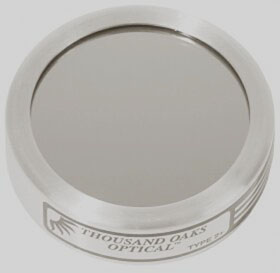
![]()
Light pollution greatly reduces the contrast of faint objects in the eyepiece of your telescope, or it will fog the film in your camera. Light from the object is still reaching your eye but it is mixed with light pollution which causes problems. To get the best view of the object you must filter out this light pollution using a "light pollution filter".
![]()
The Lumicon UHC filter is simply the best filter made in the world at combining efficiency (high visual transmission) with visual contrast (narrow bandpass). The Lumicon UHC filter typically has 92-97% transmission on all three visible nebula emission lines combined with a narrow 24nm bandpass. The Ultra High Contrast Filter is a narrow band pass filter that lets through the two oxygen III and the hydrogen beta line while eliminating most of the remaing visual spectrum. The resulting filter yields high contrast views of all types of nebula. The Ultra High Contrast Filter is not recommended for photography. The Ultra High Contrast Filter is best suited for telescopes of longer focal ratio (f/6 or longer).

Bandpass Diagram
![]()
Binocoli, Fotocamere ed accessori
Pentax PCF V 10X50
I Binocoli Pentax Serie PCF V a prisma BaK4 di Porro, offrono un'estesa gamma di ingrandimenti e applicazioni, oltre a prestazioni ottiche decisamente notevoli e una durata eccellente. La serie V è una gamma di binocoli di alta precisione frutto dell'avanzata tecnologia e dell'esperienza maturata da Pentax in campo ottico. Il sitema ottico che impiega vetri ad alta rifrazione, un trattamento a strati multipli ed oculari asferici, consente di ottenere una straordinaria brillantezza e nitidezza di immagine su tutto il campo visivo. L'ampia distanza tra gli oculari assicura eccezionale visione senza affaticare gli occhi mentre la filettatuira di attacco al treppiede assicura osservazioni prolungate stabili Il design di alta qualità comprende un meccanismo di scorrimento degli oculari provvisti di ghiere in gomma.Tutti i modelli PCF V offrono prestazioni ottiche di rilievo, eccellente comfort di visione ed eleganti finiture nere.Grazie al supersperimentato progetto ottico a prismi di Porro, al vetro ottico BAK4 ad alta rifrazione e all'impiego di lenti asferiche, tutti i modelli PCF V offrono immagini brillanti di elevato contrasto con aberrazioni residue ridotte al minimo.
Ingrandimento 10X;Diametro obiettivo in mm 50 Angolo campo 5,0°; Campo visivo a 1000m 87mt.;Pupilla d'uscita in mm. 5,0; Distanza di accomodamento dell'occhio 20; Luminosità relativa 25,0; Campo di messa a fuoco da... all'infinito. 5,0mt.;Peso in gr. 960.
Le altre caratteristiche comprendono:
· Prestazioni ottiche di alta qualità
· Proiezione arretrata di 20 mm
· Anelli oculari elicoidali con regolazione dottrica con fermi a scatto
· Design raffinato · Anello di messa a fuoco con dispositivo di blocco
· Coprioculari con protezione anti-pioggia
· Filettatura per attacco a treppiede.
![]()
Manfrotto 390
E' una combinazione 'ready-to-go', compatta e leggera, composta da treppiede e testa Junior. Quest'ultima è premontata con la colonna centrale (che è comunque reversibile, consentendo riprese da terra).
Grazie alle quattro sezioni, tutto sta in appena 56cm. È una soluzione molto pratica per escursione, viaggi e vacanze con fotocamere compatte, piccole digitali (anche video) e 35mm. Altezza massima applicabile 1,60 m.Testa+treppiedi: 1,9kg.
![]()
Sony DSC-P51 Macchina fotografica digitale Cyber-shot
2.0 Megapixel CCD Super HAD 1/2,7" da 2.1 Megapixel Risoluzione max. foto 1600x1200 12 bit DXP Supporto: Memory Stick Obiettivo: F: 3,8 / f: 6,3-12,6 mm (fotografico. 41-82 mm) Zoom 2x ottico / 6x digitale Focus Range: 80 mm ~ 8 Mirino ottico Monitor LCD a colori 1,6" TFT / 4 cm / 61.600 pixel Controllo esposizione / nitidezza Esposimetro: Multi Area / Spot Auto Focus: Centrale ponderato / Multipoint Regolazione sensibilita ISO (3) Bilanciamento del bianco (4) Program AE: 3 modalita NR: Clear Colour / Slow Shutter Formati foto: JPEG (Normal / E-Mail / Multi-Burst) Effetti speciali (4) Funzioni immagine: Index / Resize / Trimming / Rotate / Slide Show / Playback Zoom (5x) Autoscatto (10 secondi) Print Mark (DPOF) Movie: MPEG HQX (no audio) / Clip Motion Funzioni Movie: Cue&Review / Divide Flash intelligente (red eye / pre-flash) AF Illuminator Copri-obiettivo automatico Interfaccia USB (compatibile PTP) Uscita Video (PAL/NTSC) Alimentazione: 2 batterie tipo AA (Nichel Metal Hydride) Autonomia: ca 100 min (LCD On) Dimensioni (LxAxP): 126,9 x 58 x 47 mm Peso: 218 g.

Memory Stick
MSA-16A - MSA-64A (X2)
Supporto di registrazione dati removibile Funziona come una scheda PC, ha capacita di memoria elevate ed e estremamente compatta e affidabile Caratteristiche tecniche Capacita di memoria da 8 Mb a 128 Mb. Supporto di registrazione flash memory Photo/Video/Dati Per macchine fotografiche digitali: Cyber-shot: tutti i modelli. Design compatto (dimensioni: 21,5x50x2,8 mm Peso: circa 4 g Resistente e facile all'uso Velocita di scrittura massima: 1,5 Mb/sec Velocita di lettura massima: 2,45 Mb/sec
![]()
Philips ToUcam Fun (PCVC730K)
Sensor CMOS,Pixels 640 (H) x 480 (V), Still image resolution 800 (H) x 600 (V), Illumination < 5 lux, Integrated lens F2.0.
Camera adjustment parameters Frame rate, contrast, brightness, gamma, saturation, colour on/off, mirror image, backlight compensation, white balance, exposure control.
Weight 110 g, Dimensions camera 84 x 67 x 47 mm (L x W x H), USB cable 2.0 m.
![]()
Vai nella sezione compravendita per vedere le ultime news
![]()
![]()
